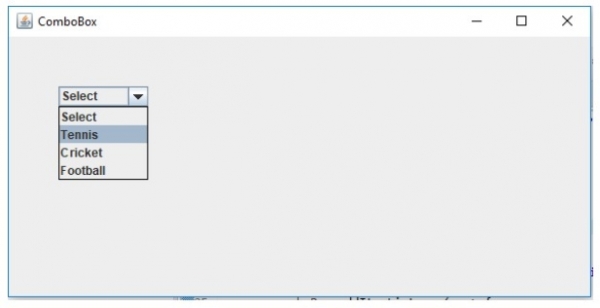
 Data Structure
Data Structure Networking
Networking RDBMS
RDBMS Operating System
Operating System Java
Java MS Excel
MS Excel iOS
iOS HTML
HTML CSS
CSS Android
Android Python
Python C Programming
C Programming C++
C++ C#
C# MongoDB
MongoDB MySQL
MySQL Javascript
Javascript PHP
PHP
- Selected Reading
- UPSC IAS Exams Notes
- Developer's Best Practices
- Questions and Answers
- Effective Resume Writing
- HR Interview Questions
- Computer Glossary
- Who is Who
Java program to disable the first item on a JComboBox
In this article, we will learn to disable the first item on a JComboBox using Java. This setup is useful for applications where you want to show a placeholder as the first item and prevent it from being chosen, so users must select a valid option. We will be using JComboBox.
JComboBox class
The JComboBox class in Java is a useful component that combines a dropdown list with a button or a text field. This lets users pick an option from the list or type their input if editing is allowed. It's great for creating forms where users can choose from options or enter something custom.
Steps to disable the first item on a JComboBox
Following are the steps to disable the first item on a JComboBox ?
- Import the required javax.swing package for implementing JFrame and JComboBox.
- Create a class named SwingDemo.
- Initialize a JFrame and a JComboBox containing the list of sports.
- Add an ItemListener to detect when an item is selected in the JComboBox.
- Within the listener, set a condition to prevent any action if the selected index is 0 (the first item).
- Display the selected index in the console for verification, but only if the selection is above index 0.
- Set up and display the frame.
Java program to disable the first item on a JComboBox
The following is an example of disabling the first item on a JComboBox ?
import javax.swing.*;
public class SwingDemo {
JFrame frame;
SwingDemo(){
frame = new JFrame("ComboBox");
String Sports[]={"Select","Tennis","Cricket","Football"};
JComboBox comboBox = new JComboBox(Sports);
comboBox.setBounds(50, 50,90,20);
frame.add(comboBox);
frame.setLayout(null);
frame.setSize(400,500);
frame.setVisible(true);
System.out.println("Index 0 (First Item) is disabled... ");
comboBox.addItemListener(e -> {
if (comboBox.getSelectedIndex() > 0) {
System.out.println("Index = " + comboBox.getSelectedIndex());
}
});
}
public static void main(String[] args) {
new SwingDemo();
}
}
Output
The output is as follows. You can now select all the indexes except index 0 (first item). Let us select the first index i.e. the second item:

Meanwhile, while selecting Tennis above, the following is displayed on Console:

Code explanation
In this program, we create a JFrame and add a JComboBox to it, initializing the combo box with four items: "Select", "Tennis", "Cricket", and "Football". The addItemListener method is used to monitor the selection. Inside this listener, we check the selected index, and if it is greater than 0, the index is printed in the console, allowing all options except the first one ("Select") to be chosen. This approach disables the first item, effectively treating it as a non-selectable placeholder.

